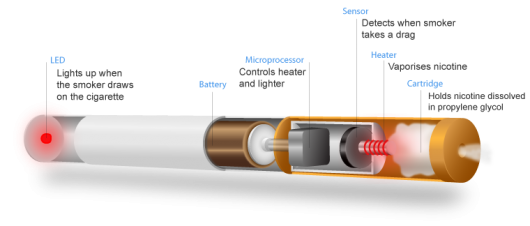Are e-cigarettes safe? An official from the Centers for Disease Control says absolutely not.
But, are they safer than regular cigarettes? Well, yes. But, Brian King says, pretty much anything is safer than regular cigarettes. And, he says, while e-cigs are touted as a way to quit smoking, a majority of people who use them still smoke cigarettes or soon will.
Dr. King spoke during a recent Ketchikan Wellness Coalition conference on tobacco. KRBD’s Leila Kheiry attended and prepared this report:
E-cigarettes, e-hookahs, vape pens, etc. – they all pretty much work the same way.
“They’re all going to have a battery, because they’re electronic, so you need a power source,” King said. “The middle is the atomizer, and this is the heating element. In order to make an aerosol, you need heat, so all these devices have a heating element. And then you have a cartridge, which contains the liquid, which is typically propylene glycol or glycerin solution. This is what we call a humectant. All that is, is it helps to produce the aerosol.”
Brian King, who works in the CDC’s Office on Smoking and Health, said calling the aerosol from e-cigarettes “vapor” is misleading.
“Because it’s not a vapor,” he said. “By definition, vapor is water droplets, and we know from the available science that it’s not just water droplets. There’s actually several harmful and potentially harmful ingredients, and what it actually produces is an aerosol.”
Electronic cigarettes are getting more popular, as advertising for those products increases. King said the market so far has been mostly unregulated, because it’s relatively new. But, the FDA just released new rules barring the sale of e-cigarettes to people under 18, requiring warning labels and requiring FDA approval for e-cigarette products.
That’s good news for King, who said youth use is on the rise, and it’s bad enough to be  considered an epidemic.
considered an epidemic.
“About 268,000 youth who had never used regular cigarettes had used e-cigarettes, and that continues to increase with time,” he said. “But interestingly, we found that the intention to smoke regular cigarettes was higher among e-cigarette users. So, the kids who used e-cigarettes were more likely to use regular cigarettes in the future.”
King said the appeal for youth is in the product’s novelty, effective advertising campaigns and the different flavors of liquid that are available. Then the addictive nicotine keeps those users coming back for more.
King said the tactics for e-cigarette marketing mirrors those used for conventional cigarettes many years ago, which isn’t a surprise since many e-cigarettes – particularly the disposable kind — are produced by major tobacco companies.
“Lest we forget that they are adjudicated racketeers,” he said. “And part of the reason that they are adjudicated racketeers is because of the manner in which they deceived the American public with advertising their products.”
One of the claims about e-cigarettes is that they can help smokers quit conventional cigarette use. King said if someone completely quits smoking regular cigarettes and transitions 100-percent to e-cigs, then there is a health benefit.
But, he said, “among current e-cigarette users, how many are using regular cigarettes? That’s high. It’s like three-quarters. What does that tell us? That a lot of them are not quitting. They’re just continuing to use both.”
And, King said, while the e-cigarette aerosol that users inhale might be better than cigarette smoke, it still contains potentially harmful chemicals, such as heavy metals, formaldehyde and flavoring compounds. Then there’s the nicotine, which constitutes a health risk, especially for pregnant women and youth.
“Nicotine is toxic to developing fetuses. It impairs fetal brain and lung development,” he said. “And nicotine use while adolescent brain is developing can disrupt brain circuit formation, particularly the prefrontal cortex.”
King said the federal government will continue to slowly enact rules for e-cigarettes. In the meantime, he said, state, local and tribal governments can step in by requiring licenses to sell e-cigs, for example, and including e-cigarettes in indoor clean-air policies.
Taxing e-cigarettes is another way to reduce use, because it increases the cost to consumers. But, King said, e-cigs shouldn’t necessarily be taxed at the same rate as regular cigarettes, because there is that potential benefit.
“What if eventually e-cigarettes are found to be effective for cessation?” he said. “What if there’s some variation of the product? Once it’s regulated, once we refine it, once we get some product maybe 10 years down the road – do you want that to be taxed at the same rate as regular cigarettes?”
Because if it is, then there’s no financial incentive to use them and completely quit what he called Public Enemy No 1 — conventional tobacco.






